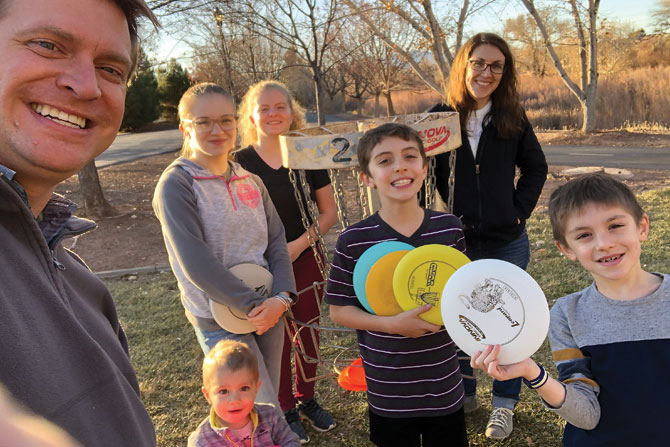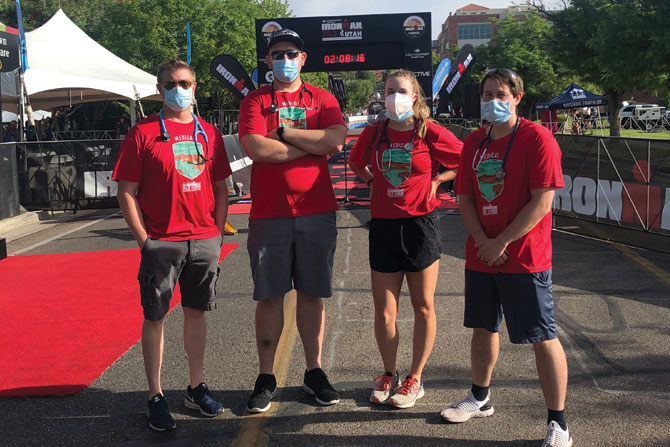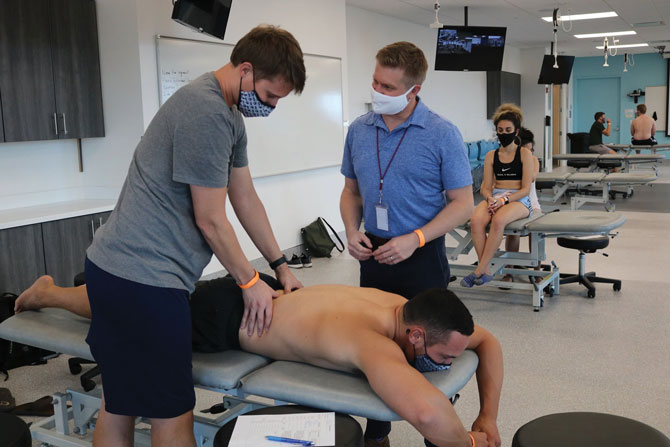Image Above: Ben Wilde teaching OMT 2020-21
First, a Little Bit About Dr. Wilde
I grew up in rural Worland, Wyoming, the oldest of seven children. My wife and I met at the University of Wyoming and now have five children ranging in age from two to 16. Although most of my free time is spent engaging with my family and their interests, my personal interests include reading, playing the piano, and getting outdoors whenever possible.
The Journey to Becoming a Physician
I earned a B.S. in Health Sciences at the University of Wyoming. I attended medical school at Midwestern University – Arizona College of Osteopathic Medicine in Glendale, AZ. I stayed an extra year as a pre-doctoral teaching fellow of osteopathic manipulative medicine and then completed my residency with Southern Illinois University in Quincy, IL.
Choosing Family Medicine
How/when did you choose family medicine as your specialty? What are some of the aspects of family medicine that drew you to it?
My father, a chiropractor, inspired my earliest interests in a career in medicine. I saw the positive impacts he had on his patients’ health and the way his patients appreciated him. This fascinated me. I noted, however, the limitations of a chiropractor’s scope of care and determined that I wanted to do so much more. I concluded that family medicine gave me the fullest potential to meet the wide-ranging needs of my patients. I appreciate that I am prepared to care for my patients medically, surgically, mentally and emotionally, in a wide variety of settings.
Did you consider another specialty? If so, what made you ultimately choose family medicine?
When I began medical school, I felt certain family medicine was for me. But when I started into my third-year clerkships, I found myself enjoying each specialty immensely. For a few months, my interests shifted first to ophthalmology and then to physical medicine and rehabilitation. Ultimately, the inherent variety of family medicine and the potential of long-term physician-patient relationships brought me back to family medicine.

The Move to Southern Utah
Prior to coming to Southern Utah, I practiced medicine in my childhood hometown in Wyoming, providing both inpatient and outpatient care, working in the emergency room, and sidelining sporting events. On arriving there, I was surprised by how quickly my family and I were embraced by the community and integrated into several events and service opportunities.
The factor that finally persuaded me to leave my rural practice was the opportunity to teach future physicians at Rocky Vista University (RVU) in Ivins, UT. Teaching had long been a passion of mine, first recognized during my pre-doctoral teaching fellowship, and my position at RVU opened to me the door of academic medicine. In addition to my teaching and leadership roles at RVU, I have continued to care for patients at the Southern Utah Veterans Home, the Doctors Volunteer Clinic, and Intermountain InstaCares in the St. George area.

Teaching Future Physicians
What drew you to teaching?
My teaching opportunities in the past, such as the pre-doctoral teaching fellowship, gave me the insight that teaching is highly rewarding for me. In many ways, I view my students’ academic successes and outcomes through the same lens I view my patients’ medical successes and outcomes. The “aha moments” students have as they learn new concepts and skills, accompanied by the gratitude they express, keep me coming back for more. It is also very satisfying to know that I am helping train up the next generation of excellent physicians.
I have also found that teaching helps keep me honest about the medical care I provide my patients. When a student is by my side and is likely to ask why I have chosen a particular diagnosis or treatment, this creates in me a feeling of accountability and helps me ensure I am consistently using evidence-based best practices in my care. The point-of-care learning and discussion that so naturally takes place when precepting a student in the clinic is a preventive measure for me against complacency, apathy, and burnout. Plus, every time the student experiences something new, their excitement is palpable. This sincere enthusiasm reminds me of the great privilege and honor it is to be a physician.
What do you enjoy about it, and are there challenges?
One of the things I enjoy most about my career in academic medicine is the opportunity to innovate. I teach primarily in preclinical years one and two at RVU. The ways I studied and learned in school almost two decades ago are very different from how students study and learn today. The newer technology, including virtual reality and high-fidelity simulation, and online resources available to support their learning are fascinating. They allow us new ways to teach and structure the learning environment and process. One challenge related to this new technology is that often students face a “paradox of choice.” Faculty can be instrumental in helping students customize their use of learning materials without becoming overwhelmed by the sheer volume of choices available.
What do you see happening with the future of medical schools, especially as it may relate to Utah?
Multiple new medical schools have recently opened their doors in Utah, resulting in significantly increased numbers of medical students training in hospitals and clinics across the state. Although the schools will innovate and use technology to train their students, nothing can really take the place of in-person face-to-face learning under the guidance of a mentor physician. Utah physicians now have more of an opportunity than ever to mentor and teach students, specifically family medicine, to inspire them to take a closer look at this important and rewarding specialty.
Some Thoughts on the Future of Family Medicine
How do we as a country/state ensure that there will be enough family physicians to meet the demand?
In my opinion, future interest in careers in family medicine must start with early outreach to students in their high school, undergraduate, and medical school years. The students need to see family physicians leading and having a positive impact at the one-on-one individual level, strengthening communities, and engaging with state and national policy. I believe the best and brightest of the students belong in family medicine, where they can make the greatest difference. With that mindset, I try to model a high standard of excellence in my teaching and leadership so students see and understand the degree of influence family physicians can have.
How can we encourage more people to pursue family medicine rather than a higher-paying specialty?
We must celebrate family medicine freely and effectively. I often have the chance to counsel students as they are choosing their medical specialty. I note that family physicians gain a large breadth of knowledge across multiple body systems, medical conditions and treatments. We also enjoy the privilege of acquiring a depth of knowledge in any system and condition of our choosing. The flexibility and variety afforded by a career in family medicine are unparalleled by any other specialty. I then remind them that, as a physician, they will be well compensated no matter what specialty they choose. Therefore, they should choose the medical specialty they enjoy the most, recognizing that their future happiness is more closely tied to their daily satisfaction than the money they will make.









